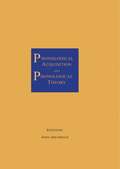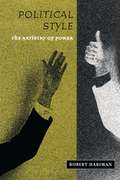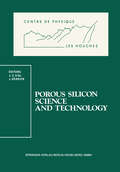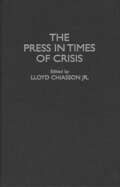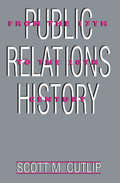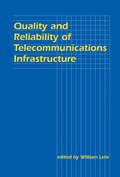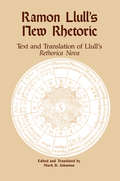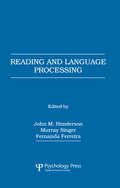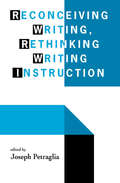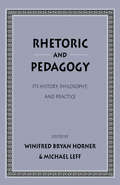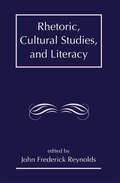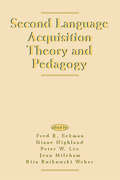- Table View
- List View
Phonological Acquisition and Phonological Theory
by John ArchibaldMuch of the work currently conducted within the framework of Universal Grammar and language learnability focuses on the acquisition of syntax. However, the learnability issues are just as applicable to the domain of phonology. This volume is the first to gather research that assumes a sophisticated phonological framework and considers the implications of this framework for language acquisition -- both first and second. As such, this book truly deals with phonological acquisition rather than phonetic acquisition.
Phonological Acquisition and Phonological Theory
by John ArchibaldMuch of the work currently conducted within the framework of Universal Grammar and language learnability focuses on the acquisition of syntax. However, the learnability issues are just as applicable to the domain of phonology. This volume is the first to gather research that assumes a sophisticated phonological framework and considers the implications of this framework for language acquisition -- both first and second. As such, this book truly deals with phonological acquisition rather than phonetic acquisition.
Political Style: The Artistry of Power (New Practices Of Inquiry Ser.)
by Robert HarimanIn this book, Robert Hariman demonstrates how matters of style—of diction, manners, sensibility, decor, and charisma—influence politics. In critical studies of classic texts, Hariman identifies four dominant political styles. The realist style, as found in Machiavelli's The Prince, creates a world of sheer power, constant calculation, and emotional control; this style is the common sense of modern political science. The courtly style, depicted in Kapuscinski's The Emperor, is characterized by high decorousness, hierarchies, and fixation on the body of the sovereign; this style infuses mass media coverage of the American presidency. The republican style, reflected in Cicero's letters to Atticus, promotes the art of oratory, consensus, and civility; it informs our ideal of democratic conversation. The bureaucratic style, as captured in Kafka's The Castle, emphasizes institutional procedures, official character, and the priority of writing; this style structures everday life. Hariman looks at effective political artistry in figures from antiquity to modern politicians such as Vaclav Havel, Ronald Reagan, and Bill Clinton. He discusses the crises to which each style is susceptible, as well as the social and moral consequences of each style's success.
Political Style: The Artistry of Power
by Robert HarimanIn this book, Robert Hariman demonstrates how matters of style—of diction, manners, sensibility, decor, and charisma—influence politics. In critical studies of classic texts, Hariman identifies four dominant political styles. The realist style, as found in Machiavelli's The Prince, creates a world of sheer power, constant calculation, and emotional control; this style is the common sense of modern political science. The courtly style, depicted in Kapuscinski's The Emperor, is characterized by high decorousness, hierarchies, and fixation on the body of the sovereign; this style infuses mass media coverage of the American presidency. The republican style, reflected in Cicero's letters to Atticus, promotes the art of oratory, consensus, and civility; it informs our ideal of democratic conversation. The bureaucratic style, as captured in Kafka's The Castle, emphasizes institutional procedures, official character, and the priority of writing; this style structures everday life. Hariman looks at effective political artistry in figures from antiquity to modern politicians such as Vaclav Havel, Ronald Reagan, and Bill Clinton. He discusses the crises to which each style is susceptible, as well as the social and moral consequences of each style's success.
Political Style: The Artistry of Power (New Practices Of Inquiry Ser.)
by Robert HarimanIn this book, Robert Hariman demonstrates how matters of style—of diction, manners, sensibility, decor, and charisma—influence politics. In critical studies of classic texts, Hariman identifies four dominant political styles. The realist style, as found in Machiavelli's The Prince, creates a world of sheer power, constant calculation, and emotional control; this style is the common sense of modern political science. The courtly style, depicted in Kapuscinski's The Emperor, is characterized by high decorousness, hierarchies, and fixation on the body of the sovereign; this style infuses mass media coverage of the American presidency. The republican style, reflected in Cicero's letters to Atticus, promotes the art of oratory, consensus, and civility; it informs our ideal of democratic conversation. The bureaucratic style, as captured in Kafka's The Castle, emphasizes institutional procedures, official character, and the priority of writing; this style structures everday life. Hariman looks at effective political artistry in figures from antiquity to modern politicians such as Vaclav Havel, Ronald Reagan, and Bill Clinton. He discusses the crises to which each style is susceptible, as well as the social and moral consequences of each style's success.
Porous Silicon Science and Technology: Winter School Les Houches, 8 to 12 February 1994 (Centre de Physique des Houches #1)
by Jean-Claude Vial Jacques DerrienThe discovery of bright visible light emission from porous silicon has opened the door to various nanometer sized silicon structures where the confinement of carriers gives rise to interesting physical properties. While the high efficiency of the light emission in the visible range is the common and the most prominent feature, their structures display similar properties with other highly divided materials (even non semiconductors), and then justify a multidisciplinary approach. This along with potential applications has attracted a large number of researchers followed by students to be trained. Until now international conferences have provided the exchange of information but have remained highly specialised so it was time to give thought to the organisation of topical and advanced lectures where the multidisciplinarity and the didactic approach are paramount. L'ecole des Houches was ideally devoted to that purpose. The meeting : " Luminescence of porous silicon and silicon nanostructures" was the first international school on this topic but some aspects in the organisation and the attendance have given an international workshop flavor to it. The school by itself has trained 82 «students», most of them were students starting their Ph. D thesis. 50% were French citizens and the other represented countries were Germany, England, USA, Czechoslovakia, The Netherlands, Italy, Japan, Poland, Spain, Canada, Brazil, India and Russia.
Practice of Public Relations
by Sam BlackPublic relations is an essential element in effective and successful business today. The theory of public relations does not change but the practice develops with new ideas and methods of management and business. This fourth edition of 'The Practice of Public Relations' incorporates essential updating and covers new areas such as: *international public relations *crisis management *sponsorship *education and training *career prospects. In 'The Practice of Public Relations' fifteen contributors give well-reasoned, practical introductions to every aspect of public relations. Keys to the many different ways in which public relations can contribute to the achievement of objectives and the successful and harmonious operation of an organization are given thorough coverage. TThis new edition has been prepared to embrace these changes so that CAM students and other readers are fully briefed on the latest issues in the realm of public relations. Sam Black, during his career, has played a significant role in the development of both the Institute of Public Relations and the International Public Relations Association. Contributors: John Cole-Morgan, Betty Dean, Rosemary Graham, Mark D Grundy, Jane Hammond, Brian Harvey, Danny Moss, Margaret Nally, Phyllis Oberman, Michael Regester, Douglas Smith, Tim Travers-Healy, Neville Wade, Sue Wolstenholme.
Practice of Public Relations
by Sam BlackPublic relations is an essential element in effective and successful business today. The theory of public relations does not change but the practice develops with new ideas and methods of management and business. This fourth edition of 'The Practice of Public Relations' incorporates essential updating and covers new areas such as: *international public relations *crisis management *sponsorship *education and training *career prospects. In 'The Practice of Public Relations' fifteen contributors give well-reasoned, practical introductions to every aspect of public relations. Keys to the many different ways in which public relations can contribute to the achievement of objectives and the successful and harmonious operation of an organization are given thorough coverage. TThis new edition has been prepared to embrace these changes so that CAM students and other readers are fully briefed on the latest issues in the realm of public relations. Sam Black, during his career, has played a significant role in the development of both the Institute of Public Relations and the International Public Relations Association. Contributors: John Cole-Morgan, Betty Dean, Rosemary Graham, Mark D Grundy, Jane Hammond, Brian Harvey, Danny Moss, Margaret Nally, Phyllis Oberman, Michael Regester, Douglas Smith, Tim Travers-Healy, Neville Wade, Sue Wolstenholme.
The Press in Times of Crisis (Contributions to the Study of Mass Media and Communications)
by Lloyd E. ChiassonThroughout American history, the press has been incredibly adept at making the public aware. The history of the press in crisis situations is in many ways the story of public attitudes and the story of America. This book looks at the press over time and the way it has functioned in times of crisis. It considers press coverage of 13 events, spanning a time frame that includes the birth of the nation, its political, economic, and social struggles as a young country, and its civil war. It tells how a young agrarian society grew into an industrial giant, and how it changed from isolationist to a world power. It relates how this country coped with the growth of socialism, two world wars, civil unrest, and with the problem of world overpopulation.The American press has performed various functions throughout the years. The Colonial Press served as a vehicle of discussion, debate, and finally agitation and, in the process, may have defined itself and laid a groundwork for the press's future roles. The press has agitated, advocated, and persuaded. It has been duped, it has been unfair, and it has misled. This volume considers such concepts as advocacy journalism, a central theme of the chapters on abolitionists and David Duke, and social responsibility, a primary part of the chapter on Japanese-American internment. The press's attempt to lead public opinion is the focus of the chapters on the partisan press, the antebellum period, and the first Red Scare in 1919. The chapter on Joseph McCarthy looks at the concepts of objectivity and the use and misuse of pseudo news. The final chapter, on overpopulation, deals extensively with agenda setting.
Public Relations History: The Antecedents
by Scott M. CutlipThis important volume documents events and routines defined as public relations practice, and serves as a companion work to the author's The Unseen Power: Public Relations which tells the history of public relations as revealed in the work and personalities of the pioneer agencies. This history opens with the 17th Century efforts of land promoters and colonists to lure settlers from Europe -- mainly England -- to this primitive land along the Atlantic Coast. They used publicity, tracts, sermons, and letters to disseminate rosy, glowing accounts of life and opportunity in the new land. The volume closes with a description of the public relations efforts of colleges and other non-profit agencies in the late 19th and early 20th centuries, thus providing a bridge across the century line. This study of the origins of public relations provides helpful insight into its functions, its strengths and weaknesses, and its profound though often unseen impact on our society. Public relations or its equivalents -- propaganda, publicity, public information -- began when mankind started to live together in tribal camps where one's survival depended upon others of the tribe. To function, civilization requires communication, conciliation, consensus, and cooperation -- the bedrock fundamentals of the public relations function. This volume is filled with robust public struggles -- the struggles of which history is made and a nation built: * the work of the Revolutionaries, led by the indomitable Sam Adams, to bring on the War of Independence that gave birth to a New Nation; * the propaganda of Alexander Hamilton, James Madison, and John Jay in the Federalist papers to win ratification of the U.S. Constitution -- prevailing against the propaganda of the AntiFederalists led by Richard Henry Lee; * the battle between the forces of President Andrew Jackson, led by Amos Kendall, and those of Nicholas Biddle and his Bank of the United States which presaged corporate versus government campaigns common today: * the classic presidential campaign of 1896 which pitted pro-Big Business candidate William McKinley against the Populist orator of the Platte, William Jennings Bryan. This book details the antecedents of today's flourishing, influential vocation of public relations whose practitioners -- some 150,000 professionals -- make their case for their clients or their employers in the highly competitive public opinion marketplace.
Public Relations History: The Antecedents
by Scott M. CutlipThis important volume documents events and routines defined as public relations practice, and serves as a companion work to the author's The Unseen Power: Public Relations which tells the history of public relations as revealed in the work and personalities of the pioneer agencies. This history opens with the 17th Century efforts of land promoters and colonists to lure settlers from Europe -- mainly England -- to this primitive land along the Atlantic Coast. They used publicity, tracts, sermons, and letters to disseminate rosy, glowing accounts of life and opportunity in the new land. The volume closes with a description of the public relations efforts of colleges and other non-profit agencies in the late 19th and early 20th centuries, thus providing a bridge across the century line. This study of the origins of public relations provides helpful insight into its functions, its strengths and weaknesses, and its profound though often unseen impact on our society. Public relations or its equivalents -- propaganda, publicity, public information -- began when mankind started to live together in tribal camps where one's survival depended upon others of the tribe. To function, civilization requires communication, conciliation, consensus, and cooperation -- the bedrock fundamentals of the public relations function. This volume is filled with robust public struggles -- the struggles of which history is made and a nation built: * the work of the Revolutionaries, led by the indomitable Sam Adams, to bring on the War of Independence that gave birth to a New Nation; * the propaganda of Alexander Hamilton, James Madison, and John Jay in the Federalist papers to win ratification of the U.S. Constitution -- prevailing against the propaganda of the AntiFederalists led by Richard Henry Lee; * the battle between the forces of President Andrew Jackson, led by Amos Kendall, and those of Nicholas Biddle and his Bank of the United States which presaged corporate versus government campaigns common today: * the classic presidential campaign of 1896 which pitted pro-Big Business candidate William McKinley against the Populist orator of the Platte, William Jennings Bryan. This book details the antecedents of today's flourishing, influential vocation of public relations whose practitioners -- some 150,000 professionals -- make their case for their clients or their employers in the highly competitive public opinion marketplace.
Quality and Reliability of Telecommunications Infrastructure (LEA Telecommunications Series)
by William H. LehrIn the last decade, the technology, regulation, and industry structure of our information infrastructure (telephone services, cable and broadcast television, and myriad new data and information services) have changed dramatically. Since the break-up of AT&T's Bell System monopoly, telephone services in the United States are no longer purchased from a single firm. Advances in fiber optics, wireless communications and software-controlled switching are changing how communication services are provided. As the global economy grows more dependent on a hybrid mix of interconnected networks, public officials in the US and abroad are relinquishing control of the market. All of these changes are affecting the quality and reliability of the telecommunications infrastructure, but informed discussions of the public policy and economic issues are scarce. Deregulation and increased competition have lowered prices, but have service quality and reliability suffered? Do advanced network technologies which make it possible to offer a dizzying array of new services increase vulnerability to system-wide failures? Who should or is likely to bear the costs of increased -- or decreased -- service quality? This volume tackles the economic and public policy issues raised by these difficult questions for an audience of industry executives, scholars, and policymakers. Leading scholars and analysts examine such issues as the effects of network ownership on incentives to invest in quality improvements and/or strategies for quality-differentiated pricing in tomorrow's broadband, integrated networks. They analyze the quality of current telecommunications networks and the impact of re-regulation on cable television quality. The contributions range from new microeconomic theory to new empirical research. As such, the volume makes a valuable contribution to the public debate on network quality and reliability. It will be useful both as an introduction to newcomers and as a resource for more experienced researchers. As regulatory, industry and national barriers to integrated communications fall, these issues are likely to become even more important. The research presented here provides a solid foundation for further discussion.
Quality and Reliability of Telecommunications Infrastructure: Quality And Reliability Of Telecommunications Infrastructure (LEA Telecommunications Series)
by William LehrIn the last decade, the technology, regulation, and industry structure of our information infrastructure (telephone services, cable and broadcast television, and myriad new data and information services) have changed dramatically. Since the break-up of AT&T's Bell System monopoly, telephone services in the United States are no longer purchased from a single firm. Advances in fiber optics, wireless communications and software-controlled switching are changing how communication services are provided. As the global economy grows more dependent on a hybrid mix of interconnected networks, public officials in the US and abroad are relinquishing control of the market. All of these changes are affecting the quality and reliability of the telecommunications infrastructure, but informed discussions of the public policy and economic issues are scarce. Deregulation and increased competition have lowered prices, but have service quality and reliability suffered? Do advanced network technologies which make it possible to offer a dizzying array of new services increase vulnerability to system-wide failures? Who should or is likely to bear the costs of increased -- or decreased -- service quality? This volume tackles the economic and public policy issues raised by these difficult questions for an audience of industry executives, scholars, and policymakers. Leading scholars and analysts examine such issues as the effects of network ownership on incentives to invest in quality improvements and/or strategies for quality-differentiated pricing in tomorrow's broadband, integrated networks. They analyze the quality of current telecommunications networks and the impact of re-regulation on cable television quality. The contributions range from new microeconomic theory to new empirical research. As such, the volume makes a valuable contribution to the public debate on network quality and reliability. It will be useful both as an introduction to newcomers and as a resource for more experienced researchers. As regulatory, industry and national barriers to integrated communications fall, these issues are likely to become even more important. The research presented here provides a solid foundation for further discussion.
Ramon Llull's New Rhetoric: Text and Translation of Llull's rethorica Nova
by Mark D. JohnstonModern histories of medieval culture often assert without qualification that the oral exercise of public eloquence during the European Middle Ages was limited to preaching by the clergy. The classical art of rhetoric supposedly survived only as a written subject for study in the schools. During the past thirty years, however, knowledge of medieval rhetorical theory and practice has grown tremendously. Historians and philologians have devoted particular attention to the relationship between oral and written communication in medieval Europe. Their investigations are beginning to suggest -- not surprisingly -- that interest in eloquence was not confined to the schools or clergy. Secular officials arguing in princely courts or town halls, and laypeople seeking to develop their learning or piety also cultivated an interest in rhetoric. Given the paucity of testimony available, the New Rhetoric of the Mallorcan lay theologian and philosopher Ramon Llull (1232-1316) offers an exceptional witness to the non-academic and non-clerical concern for eloquence. His proposals for new Christian arts of communication are among the best evidence available for assessing the diffusion of rhetorical doctrines from the cloisters and schools into the courts, town halls, and private chapels of Western Europe around 1300. Growing interest in Llull's work and in medieval rhetoric have combined to produce this first published edition. The first part on order shows how Llull's entire program attempts to correlate ethical, metaphysical, and linguistic categories into a single system of Anselmian "rightness." The next section on beauty could almost form a complete art of preaching in itself, thanks to the brief compilations of sermon material that it includes. The broad range of discursive elements and techniques in which Llull seeks verbal beauty makes this section very eclectic in scope. Part three on knowledge attempts to explain the diffusion of right linguistic and rhetorical doctrine almost exclusively through the Divine Dignities and other categories of the Great Art. The final section on love consists of ten proverbs regarding loving speech, each explicated with an appropriate exemplum.
Ramon Llull's New Rhetoric: Text and Translation of Llull's rethorica Nova
by Mark D. JohnstonModern histories of medieval culture often assert without qualification that the oral exercise of public eloquence during the European Middle Ages was limited to preaching by the clergy. The classical art of rhetoric supposedly survived only as a written subject for study in the schools. During the past thirty years, however, knowledge of medieval rhetorical theory and practice has grown tremendously. Historians and philologians have devoted particular attention to the relationship between oral and written communication in medieval Europe. Their investigations are beginning to suggest -- not surprisingly -- that interest in eloquence was not confined to the schools or clergy. Secular officials arguing in princely courts or town halls, and laypeople seeking to develop their learning or piety also cultivated an interest in rhetoric. Given the paucity of testimony available, the New Rhetoric of the Mallorcan lay theologian and philosopher Ramon Llull (1232-1316) offers an exceptional witness to the non-academic and non-clerical concern for eloquence. His proposals for new Christian arts of communication are among the best evidence available for assessing the diffusion of rhetorical doctrines from the cloisters and schools into the courts, town halls, and private chapels of Western Europe around 1300. Growing interest in Llull's work and in medieval rhetoric have combined to produce this first published edition. The first part on order shows how Llull's entire program attempts to correlate ethical, metaphysical, and linguistic categories into a single system of Anselmian "rightness." The next section on beauty could almost form a complete art of preaching in itself, thanks to the brief compilations of sermon material that it includes. The broad range of discursive elements and techniques in which Llull seeks verbal beauty makes this section very eclectic in scope. Part three on knowledge attempts to explain the diffusion of right linguistic and rhetorical doctrine almost exclusively through the Divine Dignities and other categories of the Great Art. The final section on love consists of ten proverbs regarding loving speech, each explicated with an appropriate exemplum.
Reading and Language Processing
by John M. Henderson Murray Singer Fernanda FerreiraThis volume was designed to identify the current limits of progress in the psychology of reading and language processing in an information processing framework. Leaders in their fields of interest, the chapter authors couple current theoretical analyses with new, formally presented experiments. The research -- cutting-edge and sometimes controversial -- reflects the prevailing analysis that language comprehension results in numerous levels of representation, including surface features, lexical properties, linguistic structures, and idea networks underlying a message as well as the situations to which a message refers. As a group, the chapters highlight the impact that input modality -- auditory or written -- has on comprehension. Finally, the studies also capture the evolution of new topic matter and ongoing debates concerning the competing paradigms, global proposals, and methods that form the foundation of the enterprise. The book presents current accounts of research on word-, sentence-, and text-processing. It will prove informative for experimental psychologists as well as investigators in cognitive science disciplines such as computer science, linguistics, and educational psychology. The book will also be very helpful to graduate students who wish to develop expertise in the psychology of language processes. For them, it collects, in a single volume, readings that are representative of progress concerning many central problems in the field. As such, it is distinct from the numerous collected volumes that concentrate on a single issue. Complete author and subject indexes facilitate effective use of the volume.
Reading and Language Processing
by John M. Henderson Murray Singer Fernanda FerreiraThis volume was designed to identify the current limits of progress in the psychology of reading and language processing in an information processing framework. Leaders in their fields of interest, the chapter authors couple current theoretical analyses with new, formally presented experiments. The research -- cutting-edge and sometimes controversial -- reflects the prevailing analysis that language comprehension results in numerous levels of representation, including surface features, lexical properties, linguistic structures, and idea networks underlying a message as well as the situations to which a message refers. As a group, the chapters highlight the impact that input modality -- auditory or written -- has on comprehension. Finally, the studies also capture the evolution of new topic matter and ongoing debates concerning the competing paradigms, global proposals, and methods that form the foundation of the enterprise. The book presents current accounts of research on word-, sentence-, and text-processing. It will prove informative for experimental psychologists as well as investigators in cognitive science disciplines such as computer science, linguistics, and educational psychology. The book will also be very helpful to graduate students who wish to develop expertise in the psychology of language processes. For them, it collects, in a single volume, readings that are representative of progress concerning many central problems in the field. As such, it is distinct from the numerous collected volumes that concentrate on a single issue. Complete author and subject indexes facilitate effective use of the volume.
Reconceiving Writing, Rethinking Writing Instruction
by Joseph PetragliaTo a degree unknown in practically any other discipline, the pedagogical space afforded composition is the institutional engine that makes possible all other theoretical and research efforts in the field of rhetoric and writing. But composition has recently come under attack from many within the field as fundamentally misguided. Some of these critics have been labelled "New Abolitionists" for their insistence that compulsory first-year writing should be abandoned. Not limiting itself to first-year writing courses, this book extends and modifies calls for abolition by taking a closer look at current theoretical and empirical understandings of what contributors call "general writing skills instruction" (GWSI): the curriculum which an overwhelming majority of writing instructors is paid to teach, that practically every composition textbook is written to support, and the instruction for which English departments are given resources to deliver. The vulnerability of GWSI is hardly a secret among writing professionals and its intellectual fragility has been felt for years and manifested in several ways: * in persistently low status of composition as a study both within and outside of English departments; * in professional journal articles and conference presentations that are growing both in theoretical sophistication and irrelevance to the composition classroom; and * in the rhetoric and writing field's ever-increasing attention to nontraditional sites of writing behavior. But, to date, there has been relatively little concerted discussion within the writing field that focuses specifically on the fundamentally awkward relationship of writing theory and writing instruction. This volume is the first to explicitly focus on the gap in the theory and practice that has emerged as a result of the field's growing professionalization. The essays anthologized offer critiques of GWSI in light of the discipline's growing understanding of the contexts for writing and their rhetorical nature. Writing from a wide range of cognitivist, critical-theoretical, historical, linguistic and philosophical perspectives, contributors call into serious question basic tenets of contemporary writing instruction and provide a forum for articulating a sort of zeitgeist that seems to permeate many writing conferences, but which has, until recently, not found a voice or a name.
Reconceiving Writing, Rethinking Writing Instruction
by Joseph PetragliaTo a degree unknown in practically any other discipline, the pedagogical space afforded composition is the institutional engine that makes possible all other theoretical and research efforts in the field of rhetoric and writing. But composition has recently come under attack from many within the field as fundamentally misguided. Some of these critics have been labelled "New Abolitionists" for their insistence that compulsory first-year writing should be abandoned. Not limiting itself to first-year writing courses, this book extends and modifies calls for abolition by taking a closer look at current theoretical and empirical understandings of what contributors call "general writing skills instruction" (GWSI): the curriculum which an overwhelming majority of writing instructors is paid to teach, that practically every composition textbook is written to support, and the instruction for which English departments are given resources to deliver. The vulnerability of GWSI is hardly a secret among writing professionals and its intellectual fragility has been felt for years and manifested in several ways: * in persistently low status of composition as a study both within and outside of English departments; * in professional journal articles and conference presentations that are growing both in theoretical sophistication and irrelevance to the composition classroom; and * in the rhetoric and writing field's ever-increasing attention to nontraditional sites of writing behavior. But, to date, there has been relatively little concerted discussion within the writing field that focuses specifically on the fundamentally awkward relationship of writing theory and writing instruction. This volume is the first to explicitly focus on the gap in the theory and practice that has emerged as a result of the field's growing professionalization. The essays anthologized offer critiques of GWSI in light of the discipline's growing understanding of the contexts for writing and their rhetorical nature. Writing from a wide range of cognitivist, critical-theoretical, historical, linguistic and philosophical perspectives, contributors call into serious question basic tenets of contemporary writing instruction and provide a forum for articulating a sort of zeitgeist that seems to permeate many writing conferences, but which has, until recently, not found a voice or a name.
Rhetoric and Pedagogy: Its History, Philosophy, and Practice: Essays in Honor of James J. Murphy
by Winifred Bryan Horner Michael Leff Jean Dietz Moss Beth S. Bennett Robert GainesTo provide a view of the history of western rhetoric, this volume presents original articles by a number of world-renowned scholars representing different countries and varying viewpoints. In discussing the status of the historical perspectives on rhetoric, these international scholars also present a tribute to James J. Murphy, whose scholarship and service did much to shape the field. The book will introduce new insights into western European rhetoric and its connections with English rhetoric.
Rhetoric and Pedagogy: Its History, Philosophy, and Practice: Essays in Honor of James J. Murphy (Rhetoric And Public Affairs Ser.)
by James J. Murphy Winifred Bryan Horner Michael LeffTo provide a view of the history of western rhetoric, this volume presents original articles by a number of world-renowned scholars representing different countries and varying viewpoints. In discussing the status of the historical perspectives on rhetoric, these international scholars also present a tribute to James J. Murphy, whose scholarship and service did much to shape the field. The book will introduce new insights into western European rhetoric and its connections with English rhetoric.
Rhetoric, Cultural Studies, and Literacy: Selected Papers From the 1994 Conference of the Rhetoric Society of America
by John Frederick ReynoldsThis volume presents a representative cross-section of the more than 200 papers presented at the 1994 conference of the Rhetoric Society of America. The contributors reflect multi- and inter-disciplinary perspectives -- English, speech communication, philosophy, rhetoric, composition studies, comparative literature, and film and media studies. Exploring the historical relationships and changing relationships between rhetoric, cultural studies, and literacy in the United States, this text seeks answers to such questions as what constitutes "literacy" in a post-modern, high-tech, multi-cultural society?
Rhetoric, Cultural Studies, and Literacy: Selected Papers From the 1994 Conference of the Rhetoric Society of America
by J. Frederick ReynoldsThis volume presents a representative cross-section of the more than 200 papers presented at the 1994 conference of the Rhetoric Society of America. The contributors reflect multi- and inter-disciplinary perspectives -- English, speech communication, philosophy, rhetoric, composition studies, comparative literature, and film and media studies. Exploring the historical relationships and changing relationships between rhetoric, cultural studies, and literacy in the United States, this text seeks answers to such questions as what constitutes "literacy" in a post-modern, high-tech, multi-cultural society?
Second Language Acquisition Theory and Pedagogy
by Fred R. Eckman Diane Highland Peter W. Lee Jean Mileham Rita Rutkowski WeberA volume on second-language acquisition theory and pedagogy is, at the same time, a mark of progress and a bit of an anomaly. The progress is shown by the fact that the two disciplines have established themselves as areas of study not only distinct from each other, but also different from linguistic theory. This was not always the case, at least not in the United States. The anomaly results from the fact that this book deals with the relationship between L2 theory and pedagogy despite the conclusion that there is currently no widely-accepted theory of SLA. Grouped into five sections, the papers in this volume: * consider questions about L2 theory and pedagogy at the macro-level, from the standpoint of the L2 setting; * consider input in terms of factors which are internal to the learner; * examine the question of external factors affecting the input, such as the issue of whether points of grammar can be explicitly taught; * deal with questions of certain complex, linguistic behaviors and the various external and social variables that influence learners; and * discuss issues surrounding the teaching of pronunciation factors that affect a non-native accent.
Second Language Acquisition Theory and Pedagogy
by Fred R. Eckman Jean Mileham Rita Rutkowski Weber Diane Highland Peter W. LeeA volume on second-language acquisition theory and pedagogy is, at the same time, a mark of progress and a bit of an anomaly. The progress is shown by the fact that the two disciplines have established themselves as areas of study not only distinct from each other, but also different from linguistic theory. This was not always the case, at least not in the United States. The anomaly results from the fact that this book deals with the relationship between L2 theory and pedagogy despite the conclusion that there is currently no widely-accepted theory of SLA. Grouped into five sections, the papers in this volume: * consider questions about L2 theory and pedagogy at the macro-level, from the standpoint of the L2 setting; * consider input in terms of factors which are internal to the learner; * examine the question of external factors affecting the input, such as the issue of whether points of grammar can be explicitly taught; * deal with questions of certain complex, linguistic behaviors and the various external and social variables that influence learners; and * discuss issues surrounding the teaching of pronunciation factors that affect a non-native accent.
